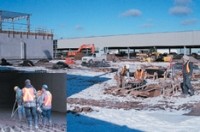Hamilton’s central composting facility opens

One-third of Hamilton, Ontario’s total residential waste stream has found a new home, thanks to the recent opening of the City’s in-vessel composting facility. The facility, designed to process 60,000 tonnes of source-separated residential organics annually, also has the additional capability to handle the equivalent of an additional 30,000 tonnes during peak periods.
The Central Composting Facility was constructed through a partnership between the City of Hamilton and Maple Reinders Constructors Ltd. and its project partners consisting of the technology partner, the Christiaens Group of the Netherlands; the facility operational partner, Aim Environmental Group of Hamilton; and its support partner, the Van Kaathoven Group of the Netherlands. The facility is employing technology that has been successfully operating in the Netherlands for two decades.
Located in Hamilton’s industrial heartland, the facility was constructed on more than eight hectares of former industrial land at a total project cost of $30.7 million which includes $5.2 million in Millennium Funding from the Province of Ontario. An MRF is also located onsite.
The facility involves three main components: an administration area, a process area and a final curing and storage area. The administration area consists of city and operator staff offices, a main control centre as well as education and meeting rooms. The main process area consists of a large tipping/receiving area, a series (Phase One and Two) of sealed concrete tunnels which are employed to contain the organics for composting and a three-phase separation screening plant for the final product. The final curing building is a fully covered structure capable of storing 12,000 cubic metres of finished product.
Once organics are delivered inside the building, raw materials are blended, shredded and placed on the conveyor belts leading to the tunnel filling cassette system. The digitally remote-controlled tunnel filling cassette system allows for the automatic and even distribution of the organics into the Phase One tunnels through the roof of the tunnel. The filling cassette system for filling of the tunnel allows for the start up of the process once an initial layer is placed in the tunnels, filling over consecutive days in the same tunnel, and minimization of or-ganics compaction during placement.
Following 7-10 days, a loader, exclusively used in the first Phase of the composting process, removes semi-composted materials from the Phase One tunnels and places the material into the Phase Two tunnels located nearby. With doors located on both ends of the Phase Two tunnels, following an additional 7-10 days in the Phase Two process, the processed compost material is taken out of the back end of the Phase Two tunnel for screening and curing.
The building operates under negative pressure with facility air being treated through a biofilter. A centralized computer air system controls temperature, humidity and air pressure within the odour control system to ensure efficiency.
Wastewater created by the composting process is collected and used to provide moisture to the composting material within the tunnels via a wall mounted spray system. The water balance for the process system is negative allowing for the re-use of all collected drain water resulting in no wastewater being discharged to the sewer.
Landscaping, topsoil manufacturing, horticultural and organic lawn care products are expected to be amongst the major markets for the facility’s finished products.
The Central Composting Facility was constructed through a partnership between the City of Hamilton and Maple Reinders Constructors Ltd. and its project partners consisting of the technology partner, the Christiaens Group of the Netherlands; the facility operational partner, Aim Environmental Group of Hamilton; and its support partner, the Van Kaathoven Group of the Netherlands. The facility is employing technology that has been successfully operating in the Netherlands for two decades.
Located in Hamilton’s industrial heartland, the facility was constructed on more than eight hectares of former industrial land at a total project cost of $30.7 million which includes $5.2 million in Millennium Funding from the Province of Ontario. An MRF is also located onsite.
The facility involves three main components: an administration area, a process area and a final curing and storage area. The administration area consists of city and operator staff offices, a main control centre as well as education and meeting rooms. The main process area consists of a large tipping/receiving area, a series (Phase One and Two) of sealed concrete tunnels which are employed to contain the organics for composting and a three-phase separation screening plant for the final product. The final curing building is a fully covered structure capable of storing 12,000 cubic metres of finished product.
Once organics are delivered inside the building, raw materials are blended, shredded and placed on the conveyor belts leading to the tunnel filling cassette system. The digitally remote-controlled tunnel filling cassette system allows for the automatic and even distribution of the organics into the Phase One tunnels through the roof of the tunnel. The filling cassette system for filling of the tunnel allows for the start up of the process once an initial layer is placed in the tunnels, filling over consecutive days in the same tunnel, and minimization of or-ganics compaction during placement.
Following 7-10 days, a loader, exclusively used in the first Phase of the composting process, removes semi-composted materials from the Phase One tunnels and places the material into the Phase Two tunnels located nearby. With doors located on both ends of the Phase Two tunnels, following an additional 7-10 days in the Phase Two process, the processed compost material is taken out of the back end of the Phase Two tunnel for screening and curing.
The building operates under negative pressure with facility air being treated through a biofilter. A centralized computer air system controls temperature, humidity and air pressure within the odour control system to ensure efficiency.
Wastewater created by the composting process is collected and used to provide moisture to the composting material within the tunnels via a wall mounted spray system. The water balance for the process system is negative allowing for the re-use of all collected drain water resulting in no wastewater being discharged to the sewer.
Landscaping, topsoil manufacturing, horticultural and organic lawn care products are expected to be amongst the major markets for the facility’s finished products.
Company info
77 James St. North
P.O.Box 2040, LCD1
Hamilton, ON
CA, L8R 2K3
Website:
hamilton.ca/index.htm



